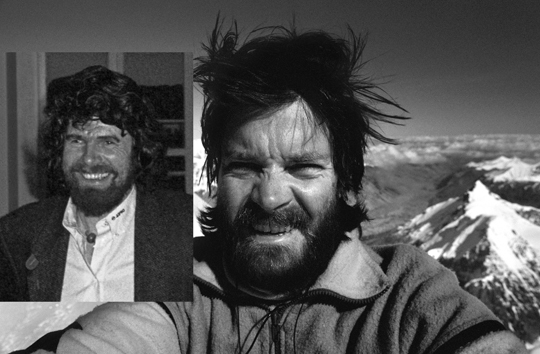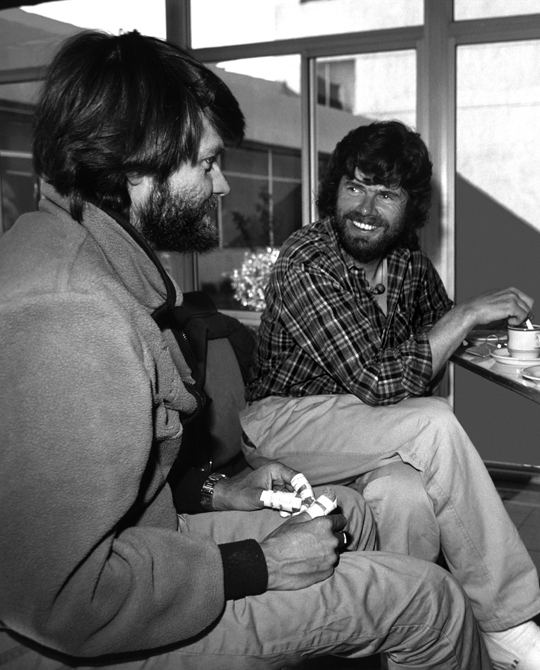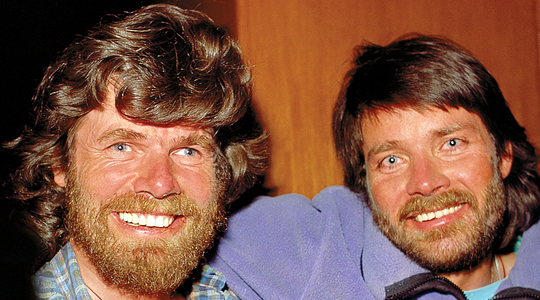
[Photo] Joe Blackburn
I didn’t really earn my Little Reinhold nickname until 1988. Here’s what Messner wrote about our next in-person meeting, in Lhasa, Tibet, in his book My Quest For The Yeti (pages 91 and 92):
“At the hotel … I met four climbers, American and English, who had just made a first successful ascent up Mt. Everest’s feared eastern wall [the Kangshung Face]. They looked awful. Their faces had been ravaged by sun and frost, their lips were cracked, and their hands were bandaged. They had been trapped on the wall for a number of days, unable to return to the base camp, without any food or enough to drink.”
But this next part of his account I have no recollection of:
“I saw them staggering along the sidewalk and called out to congratulate them, but they didn’t react. All four seemed to be limping. One kept looking over in my direction and waving his arms in a strange way. I couldn’t understand why.”
“We talked late into the night. Ed Webster was there, as was Stephen Venables, both excellent climbers. I had the feeling that they had experienced more on … Mt. Everest than they had [yet to] come to grips with. Webster still seemed disoriented.”
Well, Reinhold didn’t quite get all the names straight, but who cares? It was actually Robert Anderson who was there, not Venables, our team’s British mountaineer and sole summiter. Our Canadian climbing partner Paul Teare, along with Venables plus our Sherpa sirdar Pasang Norbu, had already headed to Kathmandu. Our four-person team in Lhasa was Robert, our expedition leader; Miriam Zieman, our doctor; Joe Blackburn, our photographer; and me. Because of frostbitten toes, Robert and I were indeed limping; I’d also frozen eight fingertips, and was visibly bandaged. We were all about to commence our flights home via Beijing.

[Photos] Ed Webster
In an outrageously enjoyable coincidence, Chris Bonington was also lodged at the Lhasa Holiday Inn with his UK climbing team, including Andy Fanshawe and Jess Stock, just back from Menlungtse, one of Tibet’s loveliest mountains. They’d achieved the bold first ascent of Menlungtse’s lower West Summit.
At the hotel in Lhasa, Messner told us quite firmly when we first met (which of course only added to his mysterious presence): “You should not even ask me why I am here.” So we didn’t. Yet it soon became evident that, coincidentally or not, both Messner and Bonington were seeking something considerably more elusive than the summit of a virgin Himalayan peak.
They had each, we soon learned, been independently searching for the Yeti, the Abominable Snowman.
“Where have you been climbing?” Reinhold asked Chris in a purposely understated tone of voice, his blue eyes laser focused.
“Um, on Menlungtse,” Chris appeared to reluctantly admit.
I almost could see Messner’s brain revving to warp speed, deciphering every nuance of Bonington’s answer.
“Ah, yes, that is a very good place to see the Yeti,” Reinhold replied.
Bonington smiled.

[Photo] Ed Webster
“What do you think the Yeti looks like?” asked Chris.
Reinhold puzzled over this for a minute. “I have a very good idea of how the Yeti appears. He has light gray or brownish fur. He can walk on all fours or upright. He eats fruits and vegetation, but also meat on occasion. And he likes to live in areas with dense trees, but sometimes he goes walking on the glaciers.”
“Then you’re convinced that they’re real?” Chris persisted.
“Yes, of course they are real,” Reinhold answered, then paused slightly before exclaiming: “I have seen one!”
This, however, was completely top-secret Yeti information–and Reinhold abruptly stopped the conversation.
Gathering at the hotel for these lively discourses, peppered with tales of our respective ascents of Mt. Everest’s Kangshung Face and Menlungtse, we grouped at tables in the dining room for breakfasts and dinners, and relaxed together for two evenings in the bar.

[Photo] Joe Blackburn
After breakfast one morning I pulled off a bandage to get Messner’s opinion of my desiccated and injured black fingertips.
Reinhold shook his head decisively from side to side.
“Pshht!” he said, performing a swift, scalpel-like slice with the edge of one hand. Then he unabashedly removed shoes and socks to show us the end results of his own frostbite amputations, injuries he’d suffered on his first Himalayan expedition, in 1970, to Nanga Parbat. Messner had one little toe left on each foot.
Robert Anderson recalled, “I still remember him taking his shoes off and showing us what was left of his toes, and saying, “It’s not so bad, I’m still a pretty good climber.”
Then Reinhold gave me some matter-of-fact advice–as though having your fingers or toes cut off were an everyday event, an inconvenience, a relatively minor mountaineering hazard, perhaps even something to be expected:
“Just be sure to tell your surgeon to smooth and round off the ends of the bones when they amputate.”
“If they make a straight cut across the bone,” he explained from personal experience, “you’ll have a sharp edge there which will push onto the nerves, and your rock climbing will hurt like hell.”
I made a mental note to definitely tell my surgeon about Messner’s “rounding off the bones” advice–and I did, several months later.
Then, musing on our successful new route up Mt. Everest’s Kangshung Face, Reinhold added a short postscript.
“You were very lucky on your climb,” Messner declared, “but then again I have often been lucky, too.”
On our last night together at the hotel bar, after several drinks, my fateful moment finally arrived. Messner and I sat down to have our picture taken.
When I confided in Reinhold that people often said that I looked like him, he replied with agility: “Oh, no–first you must lose some more toes and I must lose some fingers!”
So, am I Reinhold Messner’s long-lost kid brother? You be the judge. I think Joe Blackburn’s marvelous portrait of us together that night in Lhasa in May 1988 proves our “family resemblance.”
Afterwards, as our party broke up, I turned to Reinhold, and with my bravery obviously boosted by alcohol, I blurted:
“All of my girlfriends have actually told me that I am much more handsome than you are.”
“Some day,” he replied without missing a beat, “you must come visit me at my castle.”

[Photo] Joe Blackburn